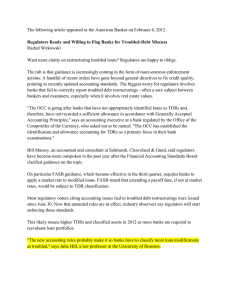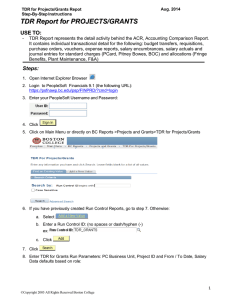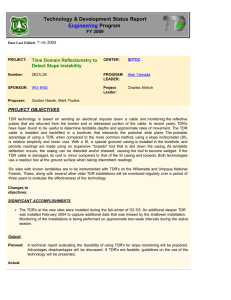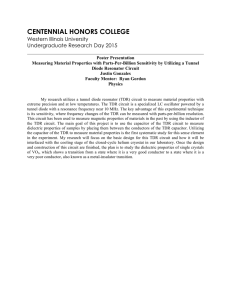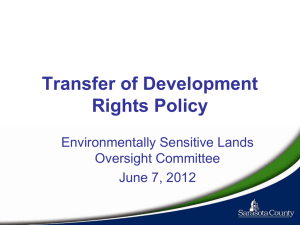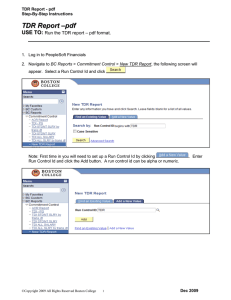DISCUSSION PAPER Markets for Development Rights
advertisement
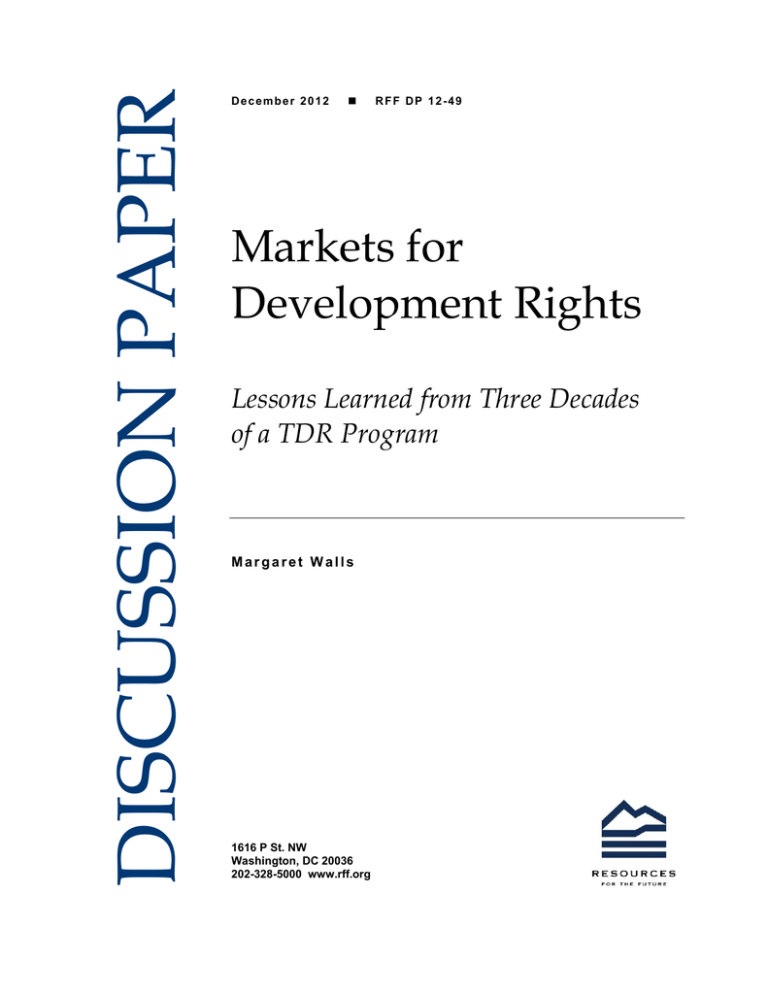
DISCUSSION PAPER December 2012 RFF DP 12-49 Markets for Development Rights Lessons Learned from Three Decades of a TDR Program Margaret Walls 1616 P St. NW Washington, DC 20036 202-328-5000 www.rff.org Markets for Development Rights: Lessons Learned from Three Decades of a TDR Program Margaret Walls Abstract Transferable development rights (TDRs) are a market-based approach to land conservation. They allow the development rights from one property to be transferred to another, with the first ―sending‖ property placed under a development restriction or conservation easement and the ―receiving‖ property permitted more dense development than would otherwise be allowed by baseline zoning regulations. This paper summarizes the economics literature on TDRs and describes a long-running program in a county in Maryland, one of the few programs with an active TDR market. It updates previously published results from the program and describes some problems that have arisen in recent years as the program has matured. The paper offers some observations as to why these problems have occurred and suggestions for other communities considering TDR programs. Key Words: TDRs, zoning, sprawl, farmland preservation, easements JEL Classification Numbers: Q24, Q28, Q15, R14 © 2012 Resources for the Future. All rights reserved. No portion of this paper may be reproduced without permission of the authors. Discussion papers are research materials circulated by their authors for purposes of information and discussion. They have not necessarily undergone formal peer review. Contents Introduction ............................................................................................................................. 1 The Economics Literature on TDRs ..................................................................................... 2 TDRs in Calvert County, Maryland...................................................................................... 5 Background on Land Use and Zoning ................................................................................ 5 TDR Program Results ......................................................................................................... 8 Impacts of the 1999 and 2003 Zoning Changes................................................................ 12 Rumblings of Discontent .................................................................................................. 14 Assessing TDR Potential....................................................................................................... 16 Concluding Remarks ............................................................................................................ 18 References .............................................................................................................................. 20 Resources for the Future Walls Markets for Development Rights: Lessons Learned from Three Decades of a TDR Program Margaret Walls Introduction Natural lands and open space can provide a range of benefits to society. In addition to private benefits from, say, livestock grazing and timber production, these lands can provide critical ecosystem services such as water storage and purification and carbon sequestration. At the local level, these services bring benefits in the form of flood protection, water quality improvements in area streams and rivers, protection of drinking water supplies, recreational opportunities, and aesthetics. In growing urban areas, however, keeping land out of development can be costly. Most local governments turn to zoning and other command-and-control-style regulations to control land uses. Some have found ways to purchase lands, or more commonly, easements, to protect land from development, but these programs usually place a heavy burden on government budgets. In the difficult economic environment faced by many communities in recent years, such programs are often first on the chopping block. A market-based alternative is a system of transferable development rights (TDRs). In most communities, local zoning regulations establish how property owners can legally develop their properties, typically specifying, for example, whether land can be put into residential, commercial, or other uses, and also regulating the intensity of use, such as the maximum number of dwelling units per acre. With TDRs, property owners can transfer these development rights to someone else. The property from which the rights are sold is placed under easement or some kind of restrictive covenant limiting development, while the ―receiving‖ property can be developed more intensively than permitted under baseline zoning regulations. Margaret Walls is a research director and the Thomas J. Klutznick Senior Fellow at Resources for the Future. I appreciate the assistance of staff in the Calvert County Department of Planning and Zoning for providing access to TDR and subdivision files and helpful discussion with Veronica Cristo in that department. This work also benefits from many conversations and advice from former director of planning and zoning Greg Bowen and from prior research with Virginia McConnell and Elizabeth Kopits. I also appreciate the helpful comments of participants in the University of California–Santa Barbara Workshop on Environmental Markets, April 18–19, 2012. Any errors are my own. 1 Resources for the Future Walls Like many market-based environmental and natural resource policies, TDRs have the virtue of being, in theory, a lower-cost approach to achieving land conservation goals than uniform zoning regulations and mandates (Mills 1980; Thorsnes and Simon 1999). By allowing flexibility in development choices across property owners, TDRs should lead to outcomes in which the properties preserved from development are those with the lowest opportunity costs in terms of forgone development values and those developed more intensively are the ones with the greatest development values. TDRs also have the virtue of not requiring a source of government revenue, in contrast to a government purchase of development rights (PDR) program. In reality, TDR programs have failed to live up to their promise. The way that many communities have designed and implemented their programs, in fact, has doomed them to failure. But some of the inherent features of TDR markets may also be to blame. In this paper, I summarize the economics literature on TDRs and describe a long-running TDR program in a county in Maryland. I update previously published results from the program and describe some problems that have arisen in recent years as the program has matured. Then I offer some observations as to why these problems have occurred and suggestions for other communities considering TDR programs. The Economics Literature on TDRs Mills (1980) was the first to analyze TDRs in a theoretical model.1 In a nonspatial model in which a fixed amount of land in a community can be put to n distinct uses, each of which requires i units of land, Mills solves for the competitive equilibrium allocation of land among different uses and shows how a system of TDRs can reach the same allocation. In Mills’s TDR framework, each unit of land is assigned a single development right, and each ith developed use requires the surrender of i development rights by its owner. He shows that TDRs preserve the gains-equalizing feature of the free market, regardless of the choice of i. TDRs can also correct for general negative externalities imposed by developed uses if i is chosen appropriately. However, if there is a site-specific externality from a particular land use—Mills uses the example of open space generating benefits to surrounding residents—Mills shows that TDRs alone will not produce a socially optimal allocation of land uses. This is because TDRs affect the total amount of development but do not address which parcels are developed and which are left as 1 Less formal approaches were taken in earlier studies (Barrows and Prenguber 1975; Berry and Steiker 1977; Field and Conrad 1975). 2 Resources for the Future Walls open space. Mills shows that if TDRs are coupled with zoning, however, the social optimum can be reached. In a graphical analysis, Thorsnes and Simon (1999) set up a similar framework for TDRs, one in which all landowners are allocated development rights in proportion to their acreage but rights can be transferred from one landowner to another. In a setting with positive externalities from agricultural land use, Thorsnes and Simon show that a competitive market will lead to too little farmland and too much development, but assigning what the authors call ―marketable development rights‖ can lead to an efficient outcome. By contrast, zoning requires local government to have too much information, as it must figure out which parcels to protect and which to develop. Mills (1980) also made this point about the difficulty in obtaining information for optimal zoning. Levinson (1997) uses a nonspatial model similar to Mills’s to show a potential downside to TDRs: they can increase overall development in a community beyond what it would be with direct land use controls. Direct controls through zoning are typically set uniformly across a group of property types because governments do not have enough information to set specific limits for each individual property. This means that some property owners are likely to be constrained by zoning while others are not; the latter type would not have exceeded the zoning limit even in the absence of the regulations. With TDRs, those unconstrained property owners sell development rights to constrained property owners and more overall development occurs. This adverse selection problem also has been highlighted as a potential issue for marketable permit systems for pollution control (Ellerman et al. 2000; Oates et al. 1989). Carpenter and Heffley (1981; 1982) look at TDR programs in a simple spatial model of urban development with a fixed supply of land for residential uses and space characterized by distance to a central business district (CBD). Identical consumers sort themselves across the landscape, and the unregulated equilibrium shows a declining density gradient—in other words, land consumption is greater the farther the consumer is located from the CBD—and a declining land rent gradient. If a minimum lot size zoning constraint is introduced into this framework, the constraint is binding for some consumers and not for others. Those constrained consumers closer to the CBD will migrate farther out, leading to zoning-induced sprawl. The authors introduce TDRs into this setting and use the notion of a ―differentiated spatial equilibrium‖ in which subsets of otherwise identical consumers are bound by different sets of constraints. The authors show how consumers in the zoning-constrained area closer to the CBD will buy development rights and those farther out will sell; in addition, there may be some consumers for whom the constraint is exactly equal to the amount of space they consume. Carpenter and Heffley 3 Resources for the Future Walls parameterize the model and conduct simulation exercises to compare spatial rents, consumption patterns, property taxes, TDR prices, and the value of TDR transfers. They find that results can vary substantially with chosen parameter values. The zoning constraint proves particularly important: results suggest that small increases in minimum lot size rules can lead to dramatic effects on the TDR market, especially large increases in TDR prices. Kopits et al. (2008) conduct one of the few empirical studies of TDRs using the Calvert County individual TDR transactions data that I describe below. Using data for the 1980–2001 time period, they econometrically estimate the demand for TDRs as a function of underlying zoning density limits, physical property characteristics, property location, surrounding land uses, and infrastructure availability. McConnell et al. (2006) also use Calvert County data to look at subdivision density and examine whether market factors or zoning regulations tend to be more important in determining density outcomes, an issue that has been a matter of debate in the economics and planning literatures (Gordon and Richardson 1997; Glaeser and Kahn 2004; Fischel 2000). Because the TDR program creates variability in the density regulations, both spatially and over time, the authors are able to separately identify the effects of zoning and other factors on density outcomes.2 Both of these studies find that the underlying zoning is key in determining both TDR demand and ultimate density outcomes and spatial patterns of development in the county.3 Kopits et al. (2008) find that TDRs are much more likely to be used in rural subdivisions than in the denser residential zones or town centers, and the number of TDRs used tends to be greater in the rural areas. Moreover, changes in the density limits are found to have a bigger effect in the rural areas. The economics literature on TDRs is somewhat limited. The theoretical models tend to conclude that TDRs are preferred to uniform zoning density limits, but the Carpenter and Heffley papers show that TDRs should be used in conjunction with density limits in situations in which 2 Quigley and Rosenthal (2005) review the evidence on the effects of zoning on housing and land prices and highlight some of the empirical difficulties associated with distinguishing the effects of regulations from market forces. See Magliocca et al. (2012) for a new simulation approach to identifying the dynamic and spatial impacts of zoning. 3 While many authors have argued that zoning is endogenous (Rolleston 1987; Wallace 1988; McMillen and McDonald 1990), the authors in these studies claim that the limited number of zoning categories in Calvert County and the stability of the designations over time—only four classifications exist and the geographic areas are virtually unchanged since the 1960s—make treatment of zoning as exogenous appropriate in the Calvert setting. Moreover, although the density limits have been adjusted a few times (see Table 1), they are mostly across-the-board reductions in density limits rather than adjustments to particular areas. 4 Resources for the Future Walls externalities vary spatially. Empirical studies are very limited because of the lack of data. Very few TDR programs have had active TDR markets with a significant number of transactions made over time. Even some of those with active markets have not maintained a database of individual transactions.4 This limits the investigations that can be conducted. In the following section, I discuss results from one program for which I have a long time series of data, the program in Calvert County, Maryland. TDRs in Calvert County, Maryland Background on Land Use and Zoning Calvert County is in southern Maryland on the western shore of the Chesapeake Bay. Its northern border is approximately 35 miles from Washington, DC, and many county residents commute to jobs in the DC area. Between 1990 and 2000, the county had the highest population growth in Maryland, 45 percent. Figure 1 shows the location of the county in the BaltimoreWashington metropolitan area. Calvert County adopted its TDR program in 1978 for the purpose of preserving farmland and forested lands from development. The program was a response to the failure of downzoning of rural lands in the preceding decade. Despite moving to minimum lot sizes, first 3 acres in the late 1960s and then 5 acres in 1975, farmland continued to be converted to development. The Calvert program, like all TDR programs in the United States, works with zoning and not in place of it. The county designated TDR ―sending‖ areas—those areas targeted for preservation where landowners could sell TDRs for use elsewhere—and ―receiving areas,‖ the areas targeted for more development. In contrast to virtually all other programs, however, the county has allowed some overlap between sending and receiving areas. Landowners whose properties are in a rural zoning classification called ―Rural Community Districts‖ (RCDs), which had 5-acre zoning at the time the program was started, have been permitted to either sell TDRs from their properties or use TDRs on their properties to develop more densely than allowed by the baseline zoning limits. Since 1999, rural properties in all zoning categories have been able to 4 Probably the best-known TDR program is the one in Montgomery County, Maryland, which has preserved 49,000 acres of agricultural land from development (Walls and McConnell 2007). The county does not keep records of TDR transactions and only makes available average TDR prices over time (which Walls and McConnell show have fluctuated wildly). 5 Resources for the Future Walls use TDRs. This feature of the Calvert program allows for more flexibility than most TDR programs, the majority of which have strict limits on where TDRs can be used (Walls and McConnell 2007; Pruetz 2003). A landowner in a rural area who chooses to enter the Calvert program must first apply to have his property designated an agricultural preservation district (APD). If approved, the county certifies the number of TDRs assigned to the property, typically 1 TDR per acre (with subtractions for existing residences). The property must keep its APD status for at least five years, during which time it must remain in active farming or forestry; if no TDRs are sold during that time, the landowner may then choose to remove the APD designation. Once the first TDR is sold, however, a permanent easement is placed on the entire property. Table 1 shows the zoning in Calvert County over time, with and without TDRs, across the different zoning classifications. For the first 20 years of the program, the targeted preservation district, farm community district/resource preservation district (FCD/RPD), had 5- 6 Resources for the Future Walls acre minimum lot sizes and TDRs could not be used in these areas, which were designated ―sending‖ areas only. The other rural zone, the rural community district (RCD), also had 5-acre minimum lot sizes, but that requirement could be cut in half with the use of TDRs, which allowed twice as many houses to be built on a given acreage. Using TDRs in the residential and town center areas provided an even more generous boost to allowable density. Table 1. Baseline Zoning Density Limits and Density Allowed with TDRs, Calvert County, MD Rural Residential Town Centers* R-2** FCD/RPD RCD 56,500 55,100 1 du/5 ac 1 du/5 ac 1 du/ac 14 du/ac 1 du/ac — 1 du/2.5 ac 4 du/ac 14 du/ac 14 du/ac Base density 1 du/10 ac 1 du/10 ac 1 du/2 ac — 1 du/ac Density w/TDRs 1 du/5 ac 1 du/2 ac*** 1 du/ac*** — 14 du/ac 1 du/20 ac 1 du/20 ac 1 du/4 ac — Land area (in acres) R-1 12,100 14,000 1978–1998 Base density Density w/TDRs 1999–2003 2003–present**** Base density Density w/TDRs 1 du/10 ac 1 du/4 ac *** 1 du/2 ac *** — * Town center density limits vary across the different town centers in the county and vary with dwelling type; the 14 du/ac limit listed in the table is representative for multifamily dwellings; single family and townhouses limits are 4 du/ac in most town centers. ** All residential areas have the same zoning after 1999. *** Density in RCD can go as high as 1 du/ac within 1 mile of a town center, with TDRs; density in residential zones can go as high as 4 du/ac within 1 mile of a town center, with TDRs. **** A new zoning ordinance took effect in May 2006, but the density limits, both with and without TDRs, did not change. Notes: The town center zoning classification came into effect in 1983. FCD stands for farm community district, RPD for resource preservation district, and RCD for rural community district. The FCD/RPD designations came into effect in 1992; designated agricultural areas (DAAs) were TDR sending areas before this time, and the 1 du/5 ac limits applied there. In the May 2006 Comprehensive Zoning Ordinance, the county combined the FCD/RPD areas into a single designation, farm and forest district (FFD). 7 Resources for the Future Walls As the table shows, most of the land area of the county—111,600 acres, or 81 percent—is in the two rural zoning categories. Because of this and because even the residential zoning classification has relatively large minimum lot sizes of 1 acre, the county is characterized by low-density patterns of development.5 Two important zoning changes have occurred since the program began. In 1999, the county downzoned across the board, doubling minimum lot sizes—i.e., halving density limits— in the two rural zoning classifications and the residential zone. This restriction on building was somewhat eased, however, by allowing developers to ―buy back‖ to the original density through purchase of TDRs. In 2003, the county repeated this process, increasing minimum lot sizes to 20 acres in the rural zones and 4 acres in the residential zone but permitting developers to go to the pre-2003 lot sizes with the purchase of TDRs. These two zoning changes were designed to control growth in the county and make additional efforts, through the TDR program, to preserve farm and forest lands. The county also hoped to shift the use of TDRs away from the rural areas and into the residential and town center zones. As I will show below, most demand for development and thus for TDRs has been in the RCD. I discuss the implications of these downzonings below. TDR Program Results Figure 2 shows the acres of farm and forest lands in permanent easement status in Calvert County from the program’s inception through 2011. As of the end of 2011, over 23,000 acres had been preserved through the sale of TDRs.6 Acreage preserved has steadily risen over time in the program, though some year-to-year fluctuations occur in the number and size of properties that enroll. In 2010 and 2011, however, enrollment decreased sharply, with no additional acreage in 2010 and only one 12-acre property entering in 2011. This is the fewest number of farms entering the program since it began in 1979. 5 The county has a very limited sewer infrastructure and heavy reliance on septic systems. This partially dictates the large lot outcomes. 6 State conservation programs and local land trusts add to this total, bringing total land under easement to approximately 26,000 acres. The county also buys TDRs and retires them, but that total is included in Figure 2. The county has a goal, laid out in its Comprehensive Plan, to reach 40,000 acres of preserved farm and forest lands. 8 Resources for the Future Walls Figure 2. Cumulative Acres of Farm and Forest Lands Preserved through Calvert County TDR Program, 1979–2011 25,000 Acres 20,000 15,000 10,000 5,000 0 Year Figure 3 shows TDR sales volumes over time and Figure 4 yearly average TDR prices, in 2011 dollars, and the maximum and minimum prices in each year. It took a few years for the program to get off the ground, but sales began to pick up in 1984. The market was particularly active during the five-year period between 1997 and 2001, with TDR sales peaking at 1,693 in 2001. Sales dropped sharply in 2002 and 2003, rebounded again in 2004, and then dropped off in 2008 with the recession and the problems in the real estate market. In total, from the beginning of the program through 2011, nearly 16,400 TDRs have been sold. Average TDR prices rose in real terms in the early years of the program but stayed relatively constant at around $3,350 between 1989 and 2003.7 After 2003, however, TDR prices have exhibited more variability across transactions, and the average sale price has increased significantly. While average prices declined in the 2009–2011 period, they still have not returned to pre-2003 levels. 7 Although there were two transactions in 1980, in which 55 TDRs were sold, no money exchanged hands. Thus the first true arms-length transaction on record is for 1983. 9 Resources for the Future Walls Figure 3. Annual TDR Sales in Calvert County, MD Price (in 2011$ per TDR) Figure 4. Maximum, Minimum, and Average Annual TDR Price in Calvert County, MD, 1983–2011 (in inflation-adjusted 2011$) $20,000 $18,000 $16,000 $14,000 $12,000 $10,000 $8,000 $6,000 $4,000 $2,000 $0 198319851987198919911993199519971999200120032005200720092011 Sale Year Average price Developers who purchase TDRs use them to increase development density in designated receiving areas. The county requires five TDRs for each additional unit built beyond the baseline density limits. This means that during the 1989–2003 period, with an average price of $3,350, 10 Resources for the Future Walls developers spent, on average, an additional $16,750 on each house they built in a TDR subdivision. With the TDR prices of today, this figure is even higher. Figure 5 shows these subdivisions for the 1980–2001 period. The figure contains two maps of the county, side by side; the first is a map that outlines the zoning classifications, and the second overlays the subdivisions and preserved farm and forest lands. The two rural designations are the RCDs, shown in white, and the FCD/RPD prime agricultural zones, shown as the blue hatched areas; residential zones are orange, and town center zones are yellow. The map on the right in Figure 5 makes clear that most subdivision development has taken place in the RCD, both subdivisions with and without TDRs. Moreover, proximity to the Baltimore-Washington metropolitan area shows up as important: both non-TDR (in pink) and TDR (in red) subdivisions tend to be located in the northern end of the county. Figure 5. Calvert County Zoning Map and Map of Development and Preservation Outcomes, 1980–2001 11 Resources for the Future Walls As described in the literature review above, Kopits et al. (2008) used the Calvert County individual TDR transactions data over the 1980–2001 time period to econometrically estimate the demand by developers for TDRs as a function of underlying zoning density limits, physical property characteristics, property location, surrounding land uses, and infrastructure availability. The study highlighted the importance of the baseline density limits, which outweighed other factors in affecting demand. Impacts of the 1999 and 2003 Zoning Changes The map in Figure 5 shows development through 2001. Since that time, county records indicate that only eight new major subdivisions were built with TDRs. In addition, TDRs were increasingly used in smaller developments, for additional lots in existing developments, and in a limited way in some multifamily dwellings. I feel that the map in Figure 5 is still indicative of the spatial patterns of development in the county and gives a good sense of the overall acreage in development. However, the 1999 and 2003 zoning changes have had profound effects on the TDR market, and anecdotal evidence suggests that they have decreased overall development in the county compared with earlier periods. Table 2 shows the number of TDRs sold and total money spent on TDRs in three time periods: 1980–1998, 1999–2007, and 2008–2011. The last time period is separated out to illustrate the effects of the recent recession and real estate market downturn. The average number of TDRs sold per year is 47 percent higher in the 1999–2007 time period, after the two downzonings, than in the 1983–1998 period. Thus the changes in the zoning density limits appear to have spurred demand for TDRs.8 They seem to have had an even larger effect on TDR expenditures: average annual dollar sales of TDRs are 283 percent higher in the 1999–2007 period than in the earlier period. This is consistent with the higher TDR prices shown in Figure 4 above and seems supportive of the findings in Carpenter and Heffley’s (1982) simulations, which show that relatively small changes in zoning can have big effects on TDR prices. The economic downturn in 2008 greatly reduced TDR sales, though the reduction in expenditures is less than the decline in number sold. 8 Kopits et al. (2008) find this result in their econometric analysis, but they have only two years of data after the 1999 downzoning. 12 Resources for the Future Walls Table 2. TDRs Sales in Calvert County, by Time Period Number of TDRs sold Avg. number sold per year Expenditures on TDRs (2011$) Avg. expenditures per year (2011$) 1983–1998 8,548 534.3 $14.25 mill $0.89 mill 1999–2007 7,090 787.7 $30.66 mill $3.41 mill 2008–2011 750 187.5 $5.47 mill $1.37 mill This increase in TDR prices during the 1999–2007 period may come as no surprise—the downzoning coupled with the increase in the TDR ―density bonus‖ in 1999 and again in 2003 should shift the demand for TDRs outward, all else equal. However, the downzoning would also be expected to increase the supply of TDRs because landowners in the rural sending areas were also downzoned. Allowing fewer houses on a given acreage reduces the opportunity cost of entering the preservation program, and thus one would expect more TDRs to be offered to the market. Indeed, according to the county planning department, the downzoning virtually halted development in the FCD/RPD areas—only 1 percent of all new lots recorded were in the FCD/RPD between 2000 and 2005 (Bowen 2006). On net, however, it appears that the demand effect has dominated the supply effect. Since 1993, the county has participated in the TDR market directly by purchasing and retiring some TDRs each year. A fixed price is announced and offered at the start of each year. Between 1993 and 2011, sales to the county accounted for approximately 38 percent of all TDR sales. During this period, the market price roughly tracked the price offered by the county.9 Since 2008, however, market prices have fallen while the county has kept its price relatively high. In 2008, the county paid $9,000 per TDR; in 2009, $8,500; and in 2011, $8,000 (it made no purchases in 2010 because of a lack of funding). Prices in market transactions during the 2008– 9 The county accounts for a much smaller percentage of the total number of transactions, but since 2001, it has offered a Leverage and Retire (LAR) program in addition to its regular Purchase and Retire (PAR) program. In the LAR program, landowners who sell their development rights to the county receive tax-free interest payments over a 15-year period and are paid the principal at the end of the 15 years, but they are required to sell all of their TDRs in these transactions. Twenty-four of the county’s 269 total TDR transactions, or 9 percent, have been LAR agreements, but they account for 58 percent of all TDRs purchased by the county. 13 Resources for the Future Walls 2011 period averaged $6,800, significantly below the county’s offers. Between 2008 and 2011, the county’s TDR purchases accounted for 45 percent of all TDRs bought and sold. In 2011, there were 15 county transactions and only 9 private ones. Rumblings of Discontent The Calvert County TDR program is one of the most successful in the country. The county has had an active private market for TDRs and as a result has permanently preserved a large amount of farm and forest lands. Purchasing the development rights itself would have cost the county nearly $50 million.10 Thus the program allowed the county to achieve some of its land preservation goals at very little direct cost to the government. By contrast, most of the approximately 150 TDR programs in the country have had inactive markets and managed to protect only small amounts of acreage (Pruetz 2003; Walls and McConnell 2007). Several factors contribute to this outcome, but a lack of demand for additional density in receiving areas—and thus a lack of demand for TDRs—is the most common problem. And the underlying reason for the lack of demand is usually the local government’s attempt to force density into areas where baseline levels are already satisfying market demand.11 Calvert’s approach of allowing TDRs to be used in some rural areas probably saved its program. But the design was not without controversy. Many urban planners decry the Calvert approach as contributing to sprawl, and farmland preservation advocates argue that the county is not actually preserving farmland but just open spaces that are not large enough for serious agricultural activities.12 The downzonings of 1999 and 2003 were, in part, a response to these criticisms, but they appear to have created their own problems. The additional restrictions imposed on building in much of the county and the high prices that developers have had to pay for TDRs to buy their way out of these restrictions have become a source of dissatisfaction among developers—many of whom were supporters of the program in earlier years because of its clear rules and simplicity. With an average price of $6,000 in 2011–2012 and five TDRs 10 This figure was calculated using the actual average TDR price over the program’s history. 11 A related problem in many communities is the existence of alternative lower-cost options for achieving density increases in designated receiving areas. Developers may be able to apply for zoning variances or so-called planned unit developments, or they may be able to build ―affordable‖ housing or senior housing and obtain density bonuses as a result. Such options can kill TDR programs. 12 Easement terms require the land to remain in active farming or forestry, but the requirements can be met with relatively minimal activities (similar to many tax breaks for agricultural land). 14 Resources for the Future Walls required for an additional dwelling unit beyond the baseline density limits, TDRs are now adding approximately $30,000 to the cost of a house. In the low-density subdivisions in the northern portion of the county, new-home prices in 2012 are typically around $450,000, but townhouses in the county seat of Prince Frederick are only about $250,000. Thus the added cost of TDRs is not insignificant. The county has clearly left the offer price in its PAR program too high in recent years, which is likely keeping the private market prices high and contributing to a lack of private market activity. The relatively stagnant TDR market has also posed problems for some landowners, particularly those who have already sold some TDRs and thus have a permanent easement on their properties. The county recently estimated that more than 11,000 TDRs are available but have yet to be sold from recorded APDs (Cristo 2012).13 The county PAR and LAR programs are oversubscribed as a result of this excess supply and the relatively high prices the county continues to offer. In 2011, out of 44 people who applied to sell TDRs to the county, only 15 were accepted.14 The rejection of many applicants is another source of problems for the county. As the program has matured, some landowners and developers have figured out ways to use some of the rules of the program to their advantage. This is creating problems for county employees in charge of monitoring the program and may be offsetting some of the land preservation accomplishments. The problems center around the acreage minimums for APDs and the exemptions allowed for individual developed lots on the APD property. A landowner with a 100-acre parcel, for example, could do better by splitting his property and enrolling it as two APDs; this would allow him to carve out more individual lots for development and still retain TDRs in proportion to the original acreage. Over the years, this activity has increased and been applied to smaller parcels. In addition, enterprising individuals have figured out ways to combine properties in such a way that they creatively maximize both the TDR and development potential from the properties. These activities have led to more small-lot development around the county. Interestingly, this kind of rent-seeking behavior is often associated with zoning, and TDRs have been held up as a way to mitigate the problem. As pointed out by Mills (1989), zoning creates incentives for landowners to spend resources to obtain the zoning regulations associated with the 13 In addition, some developers and others have bought TDRs from landowners but have yet to use them in developments. The county is unable to accurately account for these TDRs. 14 In recent years, the county has set a rule that it will only purchase up to five TDRs from each seller through its PAR program; 13 of the 15 applicants in 2011 sold to the PAR program and 2 to the LAR program. 15 Resources for the Future Walls highest-valued uses. Unfortunately, it is possible that TDR programs may create their own rentseeking behavior in some cases. The Calvert program is much more straightforward in its design than other TDR programs, yet it still has created apparent loopholes and room for strategic behavior. Along with these recent problems has come a change in leadership in the county. The program’s longtime advocate, who served as the director of the Department of Planning and Zoning for the last several years, retired in mid-2011. The new leadership is less committed to the TDR program and appears to see the current problems as potential reasons to move away from TDRs. It will be interesting to see how things evolve in Calvert County. Assessing TDR Potential Beyond farmland preservation, many communities are currently searching for ways to provide so-called ―green infrastructure‖—wetlands, forests, and other natural lands that may help reduce stormwater runoff and improve water quality in area waterways, protect drinking water supplies, and reduce flooding. Given the difficulty in finding adequate public funds to pay for land and easement purchases and the backlash from property owners when lands are downzoned, the TDR option could have much appeal. Could the 33-year-old Calvert County TDR program serve as a model for these communities and illustrate the strengths of the TDR approach, or do the program’s shortcomings and the recent setbacks in the county highlight the inherent problems with a market-based mechanism for land preservation? If a community has a simple objective of preserving a specific number of acres of land from development, it can achieve that objective more efficiently with TDRs than with a uniform zoning regulation. If the goal is to preserve land in specific areas, such as a floodplain or land in close proximity to key waterways, or with certain characteristics, such as steep slopes or particular soil types, then the community will need to use TDRs in concert with zoning controls and not in place of them. And it is critical to set both the zoning rules and the parameters of the TDR program in such a way that there is adequate demand and supply of TDRs to the marketplace. This means that landowners in the targeted preservation area see a greater monetary gain from selling TDRs and preserving their land than from developing it, and that the housing market in the receiving area is constrained by baseline zoning and thus supports a demand for additional density and TDRs. The Calvert County program succeeded in this regard, as an active functioning private TDR market has existed for many years. By contrast, activity in most other programs around the country has been quite limited. 16 Resources for the Future Walls Even when TDR programs are well designed, however, problems can arise. Thin markets may be an issue, especially because the programs are typically implemented in a single jurisdiction, which limits the number of buyers and sellers. As a result, prices may not fully reflect gains from trade. Markets were thin in the early years of the Calvert program, and the same could be true in the current moribund market. Relatedly, developers (or landowners) may have market power in some communities and inhibit the market from reaching an efficient outcome (Hahn 1984). The existence of transaction costs is another potential problem with TDRs. In a new created market with no formal exchange, buyers and sellers may have difficulty finding each other and making trades. When transaction costs are high, they can dissipate the gains from a market-based approach (Stavins 1995). In TDR programs, brokers can help minimize transaction costs. In some programs, the government acts as a broker; in others, private real estate agents serve the role. But in some programs, such as Calvert’s, the financial gains from brokering do not appear to be large enough to cover the costs, and an active TDR brokering business fails to establish itself. A new approach adopted in some communities is TDR with a ―fee in lieu‖ option. In these programs, developers who cannot find a willing seller of TDRs pay a fee to the local government instead; the government, in turn, uses the fee revenues to purchase development rights.15 It remains to be seen whether these programs will be successful. Probably the biggest hurdle for TDRs is the administrative burden for local governments. TDR programs can be relatively complex to manage. They require a careful documentation and tracking system and careful oversight by planning department staff. In this way, they are like many market-based environmental policies; effective monitoring and enforcement are key (Malik 1990; Cohen 1999). Perhaps most important, TDR programs appear to need a champion within local government. This was true in Calvert County for many years and appears essential for program success. If these problems can be overcome and the TDR program and accompanying zoning regulations set up to achieve an active private market for development rights, then TDRs have much to recommend them. They avoid the ―takings‖ problems associated with strict downzoning. They avoid the need for a source of funding as with PDRs. And unlike with strict 15 According to Pruetz (2009), the communities that have adopted the fee-in-lieu option include Livermore, California; Scarborough, Maine; Berthoud, Colorado; Clifton Park and Goshen, New York; and Seattle, Washington. 17 Resources for the Future Walls downzoning and with PDRs, TDRs accommodate growth rather than slowing it, since they work to alter the spatial patterns and density of development but not necessarily the overall extent of development. This can be important in many communities. Concluding Remarks TDR programs have much to recommend them, but as with many market-based approaches to environmental and natural resource problems, the devil is in the details. As I have noted elsewhere, a good understanding of local land and housing markets and a TDR program design that appropriately captures the demand for additional density in designated receiving areas and a healthy supply of development rights from sending areas are essential for functioning markets. And functioning markets are a necessary condition for achieving land preservation goals through TDRs. But as the Calvert County program shows, problems can still arise even when markets appear to be working. Three factors seem to have created problems in the Calvert program. First, as a response to development pressures, and because the TDR program was working well, the county essentially ―doubled down‖ on the program in 1999 and 2003. In retrospect, this may have been a bad idea, as it greatly increased TDR prices and the cost of development. Second, as the Calvert program has matured, it appears to be hitting some snags. These snags include difficulty bringing new landowners into the program to preserve their land, enterprising developers and residents who have learned to manipulate the system, and an inventory of unsold development rights from preserved properties. Third, the recent recession and downturn in real estate markets have affected the TDR program. It is hard to know without further research whether the current dissatisfaction with the TDR program in Calvert County and the inactivity in the markets are mainly a result of this third factor or other more fundamental issues. More research by economists is needed on how TDR programs can and should operate over both time and space. In particular, with a fixed supply of land in a jurisdiction, what issues may arise as a program matures? TDRs are not like tradable emissions permit systems, in which annual emissions are capped and firms trade with one another on an ongoing basis. TDRs are, for the most part, onetime transfers: landowners sell their rights to developers, who use them to build houses. Once that development is complete, the transactions are over. Decisions to preserve and develop land are essentially irreversible. All economic analyses of TDRs thus far have been static in nature and do not address issues that may arise with year-to-year fluctuations in demand and supply, as well as depletion over time of a fixed supply of land and development rights. More research is needed to better understand whether TDRs are a useful policy instrument for a 18 Resources for the Future Walls variety of land-related environmental problems, and if so, how best to design TDR programs to achieve efficient outcomes. 19 Resources for the Future Walls References Barrows, R., and B. Prenguber. 1975. Transfer of Development Rights: An Analysis of a New Land Use Policy Tool. American Journal of Agricultural Economics 57: 549–57. Berry, D., and G. Steiker. 1977. An Economic Analysis of Transfer of Development Rights. Natural Resources Journal 17: 55–80. Bowen, Gregory. 2006. Personal communication between Gregory Bowen, director of Calvert County Department of Planning and Zoning, and the author. June 10. Carpenter, Bruce E., and Dennis R. Heffley. 1981. A Spatial Equilibrium Analysis of Flexible Zoning and the Demand for Development Rights. Environment and Planning A 13(2): 273–84. ———. 1982. Spatial-Equilibrium Analysis of Transferable Development Rights. Journal of Urban Economics 12(3): 238–61. Cohen, Mark A. 1999. Monitoring and Enforcement of Environmental Policy. In The International Yearbook of Environmental and Resource Economics 1999/2000, edited by Henk Folmer and Tom Tietenberg. Cheltenham, UK: Edward Elgar Publishing, 44–106. Cristo, Veronica. 2012. Calvert County Department of Planning and Zoning memo. January 3. Ellerman, Denny, Paul Joskow, Richard Schmalensee, Juan-Pablo Montero, and Elizabeth Bailey. 2000. Markets for Clean Air: The U.S. Acid Rain Program. New York: Cambridge University Press. Field, Barry C., and Jon M. Conrad. 1975. Economic Issues in Programs of Transferable Development Rights. Land Economics 51(4): 331–40. Fischel, William. 2000. Zoning and Land Use Regulation. In Encyclopedia of Law and Economics. Vol. 2, Civil Law and Economics, edited by B. Boudewijn and G. De Geest. Cheltenham, UK: Edward Elgar, 403–23. Glaeser, Edward L., and Matthew Kahn. 2004. Sprawl and Urban Growth. In Handbook of Urban and Regional Economics, edited by J. V. Henderson and J. F. Thisse, Amsterdam: Elsevier, 2481–2527. Gordon, Peter, and H. Richardson. 1997. Are Compact Cities a Desirable Planning Goal? Journal of the American Planning Association 63(1): 95–105. 20 Resources for the Future Walls Hahn, Robert W. 1984. Market Power and Transferable Property Rights. Quarterly Journal of Economics 99(4): 753–65. Kopits, Elizabeth, Virginia McConnell, and Margaret Walls. 2008. Making Markets for Development Rights Work: What Determines Demand? Land Economics 94(1): 1–16. Levinson, Arik. 1997. Why Oppose TDRs?: Transferable Development Rights Can Increase Overall Development. Regional Science and Urban Economics 27: 283–96. Magliocca, Nicholas, Virginia McConnell, Margaret Walls, and Elena Safirova. 2012. Zoning on the Urban Fringe: Results from a New Approach to Modeling Land and Housing Markets. Regional Science and Urban Economics 42(January): 198–210. Malik, Arun S. 1990. Markets for Pollution Control When Firms Are Noncompliant. Journal of Environmental Economics and Management 18: 97–106. McConnell, Virginia, Margaret Walls, and Elizabeth Kopits. 2006. Zoning, TDRs and the Density of Development. Journal of Urban Economics 59(3): 440–57. McMillen, Daniel, and John F. McDonald. 1990. A Two-Limit Tobit Model of Suburban LandUse Zoning. Land Economics 66(3): 272–82. Mills, David E. 1980. Transferable Development Rights Markets. Journal of Urban Economics 7: 63–74. ———. 1989. Is Zoning a Negative-Sum Game? Land Economics 65(1): 1-12. Oates, Wallace, Paul Portney, and Albert McGartland. 1989. The Net Benefits of Incentivebased Regulation: A Case Study of Environmental Standard Setting. American Economic Review 79: 1233–42. Pruetz, Rick. 2003. Beyond Takings and Givings: Saving Natural Areas, Farmland and Historic Landmarks with Transfer of Development Rights and Density Transfer Charges. Burbank, CA: Arje Press. ———. 2009. Personal communication with the author, May 12. Rolleston, B. 1987. Determinants of Restrictive Suburban Zoning: An Empirical Analysis. Journal of Urban Economics 2(1): 1–21. Quigley, John and Larry A. Rosenthal. 2005. The Effects of Land Use Regulationon the Price of Housing:What Do We Know? What Can We Learn? Cityscape: A Journal of Policy Development and Research 8(1): 69-137. 21 Resources for the Future Walls Stavins, Robert N. 1995. Transactions Costs and Tradeable Permits. Journal of Environmental Economics and Management 29(2): 133–48. Thorsnes, Paul, and Gerald P. W, Simon. 1999. Letting the Market Preserve Land: The Case for a Market-Driven Transfer of Development Rights Program. Contemporary Economic Policy 17(2): 256–66. Wallace, Nancy E. 1988. The Market Effects of Zoning Undeveloped Land: Does Zoning Follow the Market? Journal of Urban Economics 23: 307–26. Walls, Margaret, and Virginia McConnell. 2007. Transfer of Development Rights in U.S. Communities: Evaluating Program Design, Implementation and Outcomes. Washington, DC: Resources for the Future. 22


